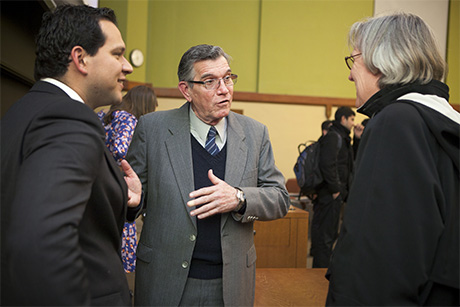Alumnus leads Panama Canal’s massive expansion
By Harrison Lewis

Innovative engineering made the Panama Canal a reality; a century later, ingenuity remains paramount for the canal to compete in a global economy, said Jorge de la Guardia, M.Eng. ’74, executive manager for the Locks Project Management Division for Panama Canal expansion in a Nov. 7 campus talk, “The Political and Economic Challenges for the Construction of the New Panama Canal.”
The $3.3 billion expansion includes constructing a third set of locks and widening the existing lanes to facilitate larger vessels. The project will improve the canal’s operational efficiency and make channel maintenance easier, and by introducing water saving basins for the new locks, it will use 7 percent less water, he said.
“The main driver of the expansion is the traffic of containers between the east coast of China and the east coast of the United States,” noted de la Guardia. The redevelopment, scheduled for completion in 2015, will permit ships three times larger than the current maximum to pass through the canal. The massive barges, known as post-Panamax vessels, can transport more cargo and provide cheaper prices to global consumers with economies of scale.
Writers of the Panamanian constitution incorporated a clause requiring a national referendum to approve the construction of new locks to ensure domestic ownership of the canal. De la Guardia oversaw 100 preliminary studies in various technical, social, environmental, financial and archaeological disciplines to optimize the expansion’s effects and mitigate possible drawbacks, he said. De la Guardia publicized the findings to the public, resulting in a pro-development referendum vote in 2006.
“International organizations have contributed to the project’s planning and feasibility,” said de la Guardia, including five multinational banks that are financing the expansion. The engineering consortium Grupos Unidos por El Canal, led by Spanish company Sacyr Vallehermoso, won the bidding war and secured the contract rights to construct the new locks. Grupos Unidos maintains research facilities around the globe that have been instrumental in developing modern hydraulic technologies, de la Guardia said.
The contract for the expansion is subject to the International Federation of Consulting Engineers and includes other binding stipulations requiring prompt reporting and substantiating of claims. Currently the consortium is behind the original schedule for an October 2014 end date and faces a penalty of $300,000 per day.
De la Guardia acknowledged the space for human error in such an extensive project. “Delays can come at any point but are to be expected overall,” he noted. Similarly, the canal expansion team factored potential environmental setbacks into their plans, such as being able to flush parts of Gatun Lake if exposed to salt water. Saltwater can contaminate the freshwater of the lake, which is used as potable drinking in many metropolitan areas in Panama.
The Panama Canal Authority anticipates recouping its losses within seven years of operating upon completion, de la Guardia said, adding that the canal expansion project is 67 percent complete and has a revised end date of June 2015.
The day before his Ithaca talk, de la Guardia outlined the massive engineering project at the Cornell Club in New York City and participated in a panel of experts, moderated by Richard Geddes, director of the Cornell Program in Infrastructure Policy and a professor of policy analysis and management, that focused on the expansion’s impact on the New York metro area.
De la Guardia’s visit was sponsored by the Cornell Institute for Public Affairs and the Cornell Program in Infrastructure Policy.
Harrison Lewis ’14 is a writer intern at the Cornell Chronicle.
Media Contact
Get Cornell news delivered right to your inbox.
Subscribe